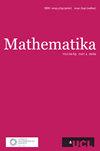米尔斯的常数是非理性的
IF 0.8
3区 数学
Q2 MATHEMATICS
引用次数: 0
摘要
表示的整数部分。1947年,米尔斯构造了一个实数,对于每一个正整数,它总是一个素数。我们把米尔斯常数定义为满足这个性质的最小实数。确定这个数字是否不合理一直是一个长期存在的问题。在本文中,我们证明了米尔斯常数是非理性的。进一步,我们得到了这个数的超越性的部分结果。本文章由计算机程序翻译,如有差异,请以英文原文为准。
Mills' constant is irrational
Let denote the integer part of . In 1947, Mills constructed a real number such that is always a prime number for every positive integer . We define Mills' constant as the smallest real number satisfying this property. Determining whether this number is irrational has been a long-standing problem. In this paper, we show that Mills' constant is irrational. Furthermore, we obtain partial results on the transcendency of this number.
求助全文
通过发布文献求助,成功后即可免费获取论文全文。
去求助
来源期刊

Mathematika
MATHEMATICS, APPLIED-MATHEMATICS
CiteScore
1.40
自引率
0.00%
发文量
60
审稿时长
>12 weeks
期刊介绍:
Mathematika publishes both pure and applied mathematical articles and has done so continuously since its founding by Harold Davenport in the 1950s. The traditional emphasis has been towards the purer side of mathematics but applied mathematics and articles addressing both aspects are equally welcome. The journal is published by the London Mathematical Society, on behalf of its owner University College London, and will continue to publish research papers of the highest mathematical quality.
 求助内容:
求助内容: 应助结果提醒方式:
应助结果提醒方式:


